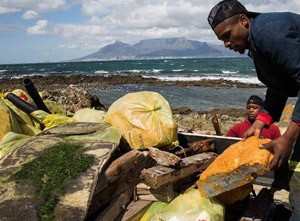PLASTICS AND ENVIRONMENT: More plastics in the Pacific than thought / Ocean Cleanup completes first aerial survey

The Great Pacific Garbage Patch, the vast accumulation of plastics waste between Hawaii and California, is at least as large as believed to be and probably bigger, the foundation Ocean Cleanup (Delft / The Netherlands; www.theoceancleanup.com) steered by 22-year-old Dutchman Boyan Slat said after completion of its first aerial expedition – see Plasteurope.com of 03.04.2013. In one of a series of low-speed, low-altitude flights across the patch in a modified C-130 Hercules aircraft, the crew of expert spotters with an experimental array of plastic scanning equipment said it had confirmed an abundance of plastic debris sized 0.5 m and up.
While the flight path followed on this trip covered only the northern boundary of the patch, the crew said it spotted and recorded more debris than what it expects to find in the heart of the accumulation zone. In around two and a half hours, more than 1,000 items of various types were counted. By using sampling nets 80 times larger than conventional scientific measurement tools, the research partners, which include Teledyne Optech (Toronto / Canada; www.teledyneoptech.com), National Oceans and Applications Research Center (NOARC, Hancock County, Mississippi / USA; www.noarc.org) and ITRES Research (Calgary / Canada; www.itres.com) discovered that the amount of in particular large debris had been “heavily underestimated, said Slat, who conceived the cleanup project four years ago while still a student.
In addition to the expected waste, an unexpected discovery were “ghost nets – discarded fishing nets many meters in diameter, which can ensnare marine life and ship’s propellers. “It was bizarre to see that much garbage in what should be pristine, Slat added. “Most of the debris was large stuff. It’s a ticking time bomb because the big stuff will crumble down to micro plastics over the next few decades if we don’t act.
The aerial survey builds on Ocean Cleanup’s first “Mega Expedition in August 2015, when a fleet of about 30 vessels crossed the patch simultaneously and took samples of debris sizes. This led to the production of the foundation’s first high-resolution map. The flights represent “an “essential milestone in preparation for the cleanup of the patch, scheduled to begin before the end of the current decade, Slat explained. In order to develop the right technology to remove the waste and to calculate the cost of removal and the logistics, he said it was essential to know the specific dimensions of the individual objects as well as the plastic accumulation as a whole.
The foundation’s research team has access to the world’s most advanced apparatus to detect the plastic, including lidar (a surveying method that measures distance to a target by illuminating that target with a laser light and multispectral camera technology), said Michel Stanier, general manager of Teledyne Optech. He said the Canadian company can leverage its more than 40 years of lidar and software experience, as well as advanced systems such as its Optech CZMIL Nova Coastal Zone Mapping and Imaging Lidar. Combining the sensor technology and human observer data, the company will be able to complete the first detailed data map of plastic in the Great Pacific Garbage Patch. The work is being funded in part by the Dutch government.
On 10 October, the crew planned to conduct a final aerial study, flying through the heart of the patch. Once all exploration flights are completed, the results from the aerial expedition will be combined with the data collected during the 2015 expedition in a peer-reviewed scientific paper expected to be published early 2017. The cleanup effort is set to get underway next year, when the research team will test the prototype of a gigantic V-shaped barrier of vulcanised rubber powered by sun and wave action, which – they hope – will be able to suck up as much of the plastics waste as possible.
If the trials are successful, it is planned to deploy a full-sized barrier by 2020. But Slat warned that a cleanup could be a waste of time if so much plastic continues to accumulate in the oceans. “Better recycling, better product design and some legislation is all part of it, he said. “We need a combination of things. A recent report by the Ellen MacArthur Foundation (Cowes / UK; www.ellenmacarthurfoundation.org) predicted that there will be more plastic than fish in the ocean by 2050 unless urgent action is taken (see Plasteurope.com of 09.02.2016).












